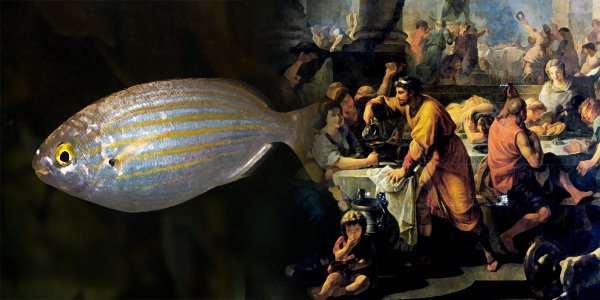This Hallucinogenic Fish Was Used By The Romans As A Recreational Drug

The Ancient Romans were known for fully utilising the land around them and used a variety of nature for an array of uses. But something that was not quite as well known of the Romans was that they used a fish called Sarpa salpa as a recreational drug.
The Romans often used the land to display their status, as well as ensuring their own survival, by utilising plants and animals for food, cosmetics, and dyes for clothing and crafts, as well as for medical purposes. It is not unusual today to hear about plants being used as drugs, as they are today, but perhaps it is unexpected to hear that the Ancient Romans used a fish to cause hallucinations. The fish is commonly known as the salema porgy, and causes hallucinogenic effects after it is consumed; this is known as ichthyoallyeinotoxism and is characterised as a type of food poisoning which can “manifest with vivid auditory and visual hallucinations, delirium, disturbances in motor coordination, nausea, nightmares, vertigo, and other disturbances to the central nervous system”, according to reports.
The unique fish is recognised by its distinctive gold stripes running down its side, and is an inhabitant of temperate and tropical areas, from the Atlantic coast of Africa and up throughout the Mediterranean Sea. Although it may appear as a normal fish living in these waters, the Romans knew that it can induce vivid, LSD-like hallucinations. In Arabic, the fish’s name means “the fish that make dreams”, and the drug like properties occur when the head is consumed in particular. As well as being used for this, it was also used ceremoniously among Polynesians.
In 2012, a study was conducted about how the fish causes the hallucinations, and was published in ‘In Vitro Cellular and Developmental Biology’. The study claimed that the effects are something to do with the fish’s diet of phytoplankton which grows on the seagrass Posidonia oceanic, although it is currently unclear exactly which toxin causes the response from those who eat the Sarpa salpa. One suggestion points to the alkaloids in the indole group, which are compounds that are naturally occurring in certain algae and phytoplankton that the fish eat, and have a similar chemical structure to LSD.
The fish first became widely known for its psychoactivity relatively recently, following widely publicised articles in 2006, where two men ate the fish at a Mediterranean restaurant and began to perceive many auditory and visual hallucinogenic effects, according to reports. Back in 1994, a 40 year old man felt sick after about two hours after he enjoyed fresh baked Sarpa salpa on his vacation on the French Riviera. He developed nausea, followed by blurred vision, muscle weakness, and vomiting. After a failed attempt at driving home due to the “screaming animals distracting him”, he recovered in hospital for 36 hours.
Read Next: 5 Questions To Ask Yourself Before Taking Psychedelics
THIS ARTICLE IS OFFERED UNDER CREATIVE COMMONS LICENSE. IT’S OKAY TO REPUBLISH IT ANYWHERE AS LONG AS ATTRIBUTION BIO IS INCLUDED AND ALL LINKS REMAIN INTACT.
Leave Comment: